Newari Architecture of Nepal
|
Read. Imagine. Travel.
Namaste! We believe that our editions on the Indian Subcontinent are keeping you intrigued as much as they did to us while writing about it! The deeper we dig into ancient practices in the Indian Subcontinent and its aspects, the feeling of sharing the interesting facts grows. So here we are, with one more edition that focuses on the “Newari architecture of Nepal”. Watch a short video on Nepal
Newars, the largest and ancient inhabitants of Kathmandu Valley, are known for their artistic, cultural, religious, and traditional values. They consider themselves the true custodians of their traditions and culture, as they have preserved the same and practicing even today, despite the modernization.
 The majority of what you see around in Nepal (monuments, artifacts, sculptures, or paintings) is Newari. The common Newari style of brick and woodwork can be seen in various buildings ranging from palaces and temples to houses. However, this architecture's unique feature is Bahal, a courtyard typical to Newari structures and Newar windows, which boasts the intricately carved woodwork unique to Nepal. Newaris skilled themselves with the art's sophistication that gave Kathmandu valley around 2500 temples, shrines, and not one or two but seven UNESCO world heritage sites. The most common Newari architecture style is Stupa, Shikhara, and Pagoda, among many.
The majority of what you see around in Nepal (monuments, artifacts, sculptures, or paintings) is Newari. The common Newari style of brick and woodwork can be seen in various buildings ranging from palaces and temples to houses. However, this architecture's unique feature is Bahal, a courtyard typical to Newari structures and Newar windows, which boasts the intricately carved woodwork unique to Nepal. Newaris skilled themselves with the art's sophistication that gave Kathmandu valley around 2500 temples, shrines, and not one or two but seven UNESCO world heritage sites. The most common Newari architecture style is Stupa, Shikhara, and Pagoda, among many.
The Pagoda style: These structures have multi tired roof ascending downwards beautifully, and the carved wood windows enhance the structure's beauty.
The Stupa style: These structures have a square base, on which the hemispherical dome with a pyramidal top rests. The style is believed to be introduced during the times of King Asoka and is believed to represent the five universal elements of earth, fire, water, space, and air.
The Shikhara style: A pyramidal shaped dome similar to a mountain peak is called Shikhara and is found in temple architecture. These shikharas are highly intricated, which adds to their beauty.
However, the most commonly seen in the valley is a double roofed Pagoda. It is believed that a similar pattern found in China, Korea, and Japan had been migrated from here only. Unfortunately, many artistic creations could not withstand the test of time. Most of the monuments we see today are of the Malla period, which is considered a golden period when art, culture, and architecture flourished to new heights. The Malla rulers of Kathmandu, Patan, and Bhaktapur were such art lovers that they were into a sort of competition adorning their respective cities with beautiful structures. The positive competition did not remain confined to them. It flowed down the line among the native craftsmen and people, and everybody was trying to build a unique masterpiece, be it a temple, Stupa or house.
Let us take you around some of the structures built in different styles.
Kathmandu Durbar Square (Pagoda Style):
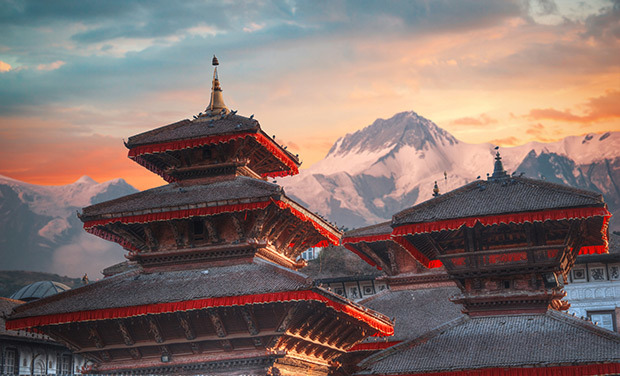 Durbar square, a typical sight in Newari architecture, is a plaza in front or in the royal palace's vicinity. It is where the coronation of the kings of Kathmandu was held. The area has numerous temples, courtyards, and palaces, including those of Mallas and Shahs around it, boasting the fine architecture by Newar artists. While the area faced much devastation because of earthquakes, it still has many to be admired. The UNESCO world heritage site is also popularly known as Hanuman Dhoka because of the statue of monkey God, Hanuman, at the palace entrance.
Durbar square, a typical sight in Newari architecture, is a plaza in front or in the royal palace's vicinity. It is where the coronation of the kings of Kathmandu was held. The area has numerous temples, courtyards, and palaces, including those of Mallas and Shahs around it, boasting the fine architecture by Newar artists. While the area faced much devastation because of earthquakes, it still has many to be admired. The UNESCO world heritage site is also popularly known as Hanuman Dhoka because of the statue of monkey God, Hanuman, at the palace entrance.
The present palaces and structures we see are not that old, as they underwent renovations many times. However, the history of the place dates back to the 03rd century to the Licchavi period, who chose this place for their royal palaces.
Interestingly, it remained the area of interest for the succeeding rulers /dynasties, including Mallas, shahs, and the last royals, and they too build their palaces over here. Pratap Malla was the most passionate about art. During his reign, the square saw much of the renovations and construction of palaces, temples, and chowks (Squares) adorned with fountains, baths, and ponds for beautification. Among the many temples, the Kasthamandapa temple was the most prominent, but before we tell you more about this temple, another important monument by Mallas needs to be introduced, Kumari Bahl. Built by the last ruler Jayapraksh Malla, the Newari palace, structured typically like a vihara, is revered as a temple where Kumari Goddess lives. Some other temples in Kathmandu Durbar square, which can be admired for their Pagoda styled structure, are Taleju Temple, Indrapur temple, Vishnu temple, Mahadev temple, and much more. While the square remains to be a happening place during various religious ceremonies (especially Indra Jatra), the chowks can always be seen crowded with people serving as a hub for socialization. It is nothing less than an open museum under the sky, and a heritage walk with our experienced guide through its alleys will give a feeling as if a time machine has taken you back to the past.
Kasthamandapa Temple (Pagoda style):
 The 16th-century Pagoda styled temple was among the oldest structures in the world made of wood. Dedicated to Lord Gorakhnath (protector of cows), the temple was built by Mallas. You will be amazed to know that the city got its name “Kathmandu” from three storyed Kasthamandapa temple. However, what's admirable of its craftsmanship was that not even a single nail had been used to hold the wooden structure, and still, it survived the earthquake in 1934.
The 16th-century Pagoda styled temple was among the oldest structures in the world made of wood. Dedicated to Lord Gorakhnath (protector of cows), the temple was built by Mallas. You will be amazed to know that the city got its name “Kathmandu” from three storyed Kasthamandapa temple. However, what's admirable of its craftsmanship was that not even a single nail had been used to hold the wooden structure, and still, it survived the earthquake in 1934.
Unfortunately, the earthquake of 2015 devastated it completely, and today one can only imagine the craftsmanship through the photographs. Although the recreation work is still going on.
Changunarayan Temple (Pagoda Style):
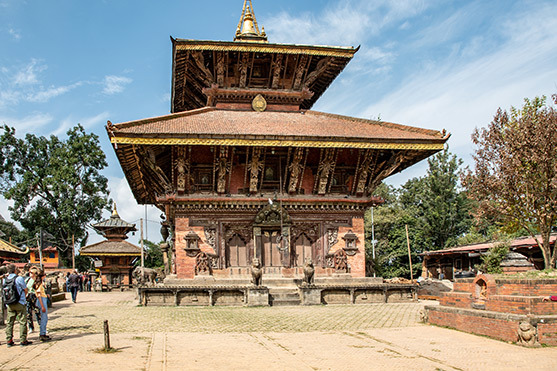 The 4th-century temple is dedicated to Lord Vishnu, who is also called Narayana. The wooden structure, raised on a stone plinth, with two Pagoda styled roofs, have many life-size sculptures and can be accessed through four entrances. Listed as a UNESCO world heritage site, this temple is located on a tranquil hilltop, also called ‘Changu’.
The 4th-century temple is dedicated to Lord Vishnu, who is also called Narayana. The wooden structure, raised on a stone plinth, with two Pagoda styled roofs, have many life-size sculptures and can be accessed through four entrances. Listed as a UNESCO world heritage site, this temple is located on a tranquil hilltop, also called ‘Changu’.
One of Nepal's oldest temples, it is considered superior in temple architecture. The way leading to the temple itself is interesting as one has to pass through the Newari settlement, which gives you a great insight into their lifestyle before seeing their architectural skills.
|
Pashupatinath Temple (Pagoda Style):
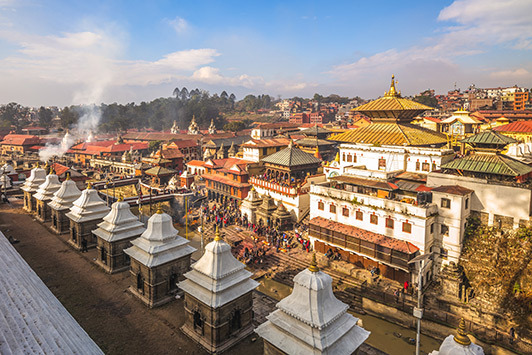 The most famous and sacred to Hindus, Pashupatinath temple on the Bagmati Riverbanks is one of Nepal's oldest temples. The two-storeyed pagoda roof gilded with gold and copper makes it distinct from other pagoda structures. The structure is raised on a square platform and has four doors coated with silver sheets on all four sides. The temple has two Sanctum Sanctorums. The outer one has a courtyard, and the inner one having the Shiva idol, also named Pashupati (Lord of all living and Non-living beings, also termed as Pashus).
The most famous and sacred to Hindus, Pashupatinath temple on the Bagmati Riverbanks is one of Nepal's oldest temples. The two-storeyed pagoda roof gilded with gold and copper makes it distinct from other pagoda structures. The structure is raised on a square platform and has four doors coated with silver sheets on all four sides. The temple has two Sanctum Sanctorums. The outer one has a courtyard, and the inner one having the Shiva idol, also named Pashupati (Lord of all living and Non-living beings, also termed as Pashus).
The UNESCO listed temple was built in the 5th century over the older structure damaged by termites. Over the period, many other temples were built in the complex, and today you can see hundreds of temples lining both sides of the river bank.
Patan Durbar Square (Pagoda Style):
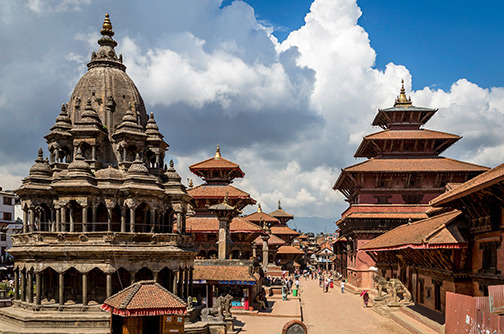 As the rulers of three kingdoms (Kathmandu, Patan, and Bhaktapur) competed against each other to beautify their kingdom with art, Patan Durbar Square also marks distinction.
As the rulers of three kingdoms (Kathmandu, Patan, and Bhaktapur) competed against each other to beautify their kingdom with art, Patan Durbar Square also marks distinction.
However, the concept is the same for all the three, like chowks, temples, Royal palaces, and sculptures. Let us introduce you to some of the admirable structures in this square:
Chyasin Dewal: Built-in 1631, the two roofed imposing structure is octagonal in shape and gives the panoramic view of Patan square when seen from its second floor.
Taleju Bell: Named after Goddess Taleju (Incarnation of Hindu Goddess Durga and worshipped by Newaris), this giant Bell was believed to be rung as a warning sign for any unwanted guest(s) in the territory.
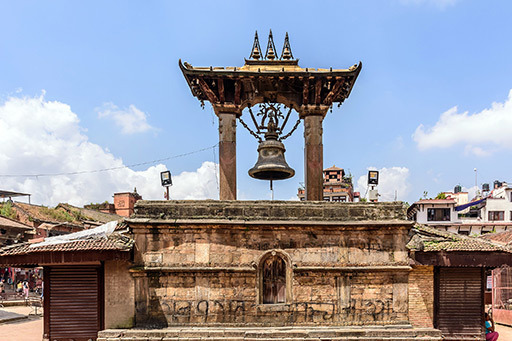
It also signaled the need for justice as it was also rung by those seeking the king's intervention for a solution to their problems.
Krishna temple: Once the magnificent structure, unfortunately earthquake snatched its charm, but still one can sense the grandeur of this Newar architecture. Nearby Vishwanath and Bhimsen temple also adds to the charm.
The Yogendra Malla's giant statue on a huge pillar has an imposing presence in the square full of impressive structures.
The architecture of Royal Residences and houses surrounds the chowks, which are an important part of the Newari architecture. These chowks were made for social gatherings and a meeting place for locals to get acquainted with each other.
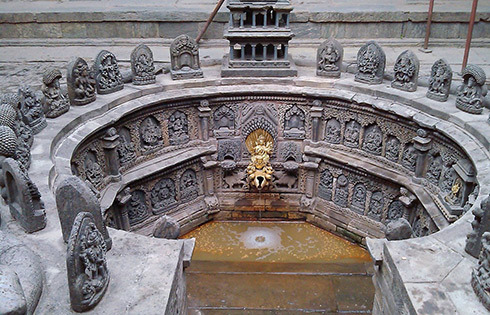 Sundari Chowk has impressively carved sculptures of deities on the gate. Behind the gates is a stunning Tushahiti stepwell that has marvelous carvings and statues.
Sundari Chowk has impressively carved sculptures of deities on the gate. Behind the gates is a stunning Tushahiti stepwell that has marvelous carvings and statues.
The one grabbing immediate attention is the statue of a deity with a golden tap. The walls of the courtyard, whose center point is this stepwell, have impressing carvings. Tushahiti served as a ceremonial bathing place for the royals.
Mul Chowk is famous for Taleju temple, a triple roofed five-storeyed structure with an entrance adorned by two golden deities. Another temple Bidya Mandir also adds to the charm of Mul Chowk.
Keshav Narayan Chowk will leave you mesmerized with the Newari artwork, especially the wooden pillars, which are carved intricately.
 The chowk guarded by Lion sculptures is named after the Keshav Narayan temple, which occupies the center place and is surrounded by royal palaces whose doors and windows will leave you amazed.
The chowk guarded by Lion sculptures is named after the Keshav Narayan temple, which occupies the center place and is surrounded by royal palaces whose doors and windows will leave you amazed.
Patan Durbar Square museum: Kathmandu has seen much devastation to its heritage buildings due to earthquakes. A portion of the royal palace has been converted into a museum to preserve the artifacts for generations to showcase the glory of Mallas and art patronized by them.
Houses in Durbar square: Newari houses are stunning piece of architecture. Many converted into schools, cafes while inhabitants still use some, the artistic details of these houses speak of the skill of Newaris.
Bhaktapur Durbar Square (Pagoda and Shikhara style):
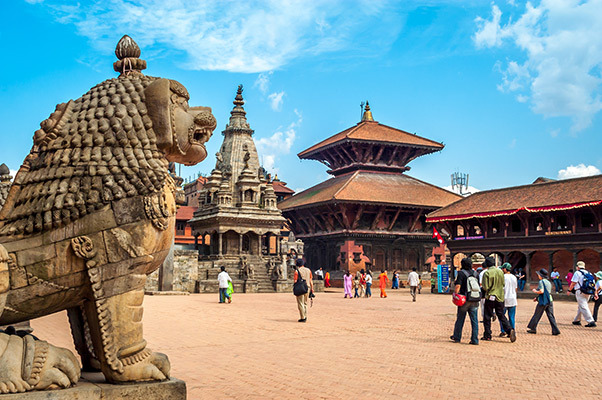 Another UNESCO world heritage site of Nepal, Bhaktapur Durbar square is a group of four squares - Durbar Square, Pottery Square, Dattatraya Square, and Taumadhi Square. Interestingly each of the squares has an architectural marvel to amaze. As the name suggests, Durbar square is the place to see royal palaces. One of the oldest royal palaces has well preserved 55 wooden windows, which will leave a discerning traveller spellbound for their intricate work. A golden gate of the palace is another feature that will grab attention. Just outside the palace, one will see Malla King's statue on a column erected facing the palace. Like Patan Durbar square, here one can see a bell as well but with a surprisingly different purpose.
Another UNESCO world heritage site of Nepal, Bhaktapur Durbar square is a group of four squares - Durbar Square, Pottery Square, Dattatraya Square, and Taumadhi Square. Interestingly each of the squares has an architectural marvel to amaze. As the name suggests, Durbar square is the place to see royal palaces. One of the oldest royal palaces has well preserved 55 wooden windows, which will leave a discerning traveller spellbound for their intricate work. A golden gate of the palace is another feature that will grab attention. Just outside the palace, one will see Malla King's statue on a column erected facing the palace. Like Patan Durbar square, here one can see a bell as well but with a surprisingly different purpose.
Whenever the Bell on Vatsala Durga temple was rung, dogs in the vicinity would start barking, and thus the Bell got its name, 'Bell of the barking dogs.' A similar kind of purpose had the war drums, which were used to alert the inhabitants about the possible war.
The famous Nayatpola temple is adorning the Taumadhi square along with the Bhairavnath temple. Nayatpola, which means a five-storeyed building, is the tallest in Nepal and was amazingly built in just 214 days. The temple is not only architecturally symbolic, but it also represents five elements through its five levels. Just left to this temple is a three-storeyed Bhairavnath temple dedicated to Lord Shiva.
Dattatraya square is named after the Dattatraya temple dedicated to Lord Dattatraya, the trio of Hindu gods, Brahma, Vishnu, and Shiva. Built in around 1427, this is one of Nepal's oldest and only temples dedicated to Lord Dattatraya. If legends have to be believed, this temple was also made of single wood.
The pottery square, as the name suggests, is almost similar to the picture reflected in your mind on reading the name.
Boudhnath Temple (Stupa style):
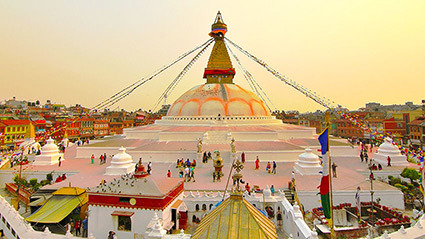 Boudhnath temple tops the list when Stupa styled structures of Newaris are discussed. The 36 meters high Stupa is a UNESCO world heritage site and built on the lines of Tibet's Gyangtse. The site had been on the trade route to Tibet and is believed to shrine the Tibetan merchants, and later it became the center for Tibetan refugees.
Boudhnath temple tops the list when Stupa styled structures of Newaris are discussed. The 36 meters high Stupa is a UNESCO world heritage site and built on the lines of Tibet's Gyangtse. The site had been on the trade route to Tibet and is believed to shrine the Tibetan merchants, and later it became the center for Tibetan refugees.
The Buddhist temple is surrounded by a number of cafes from where you can enjoy beautiful views of this imposing structure. On the top of the dome, it has giant pair of Buddha eyes on all four sides, which are believed to symbolize the all seeing ability of Buddha.
Swyambhunath Stupa (Stupa style):
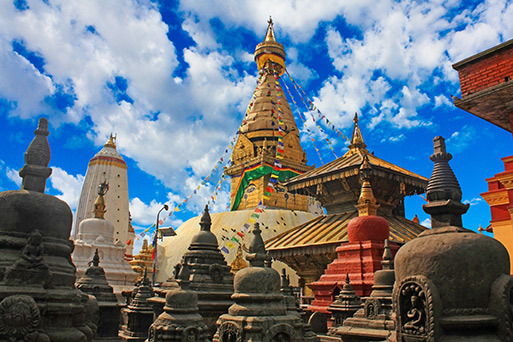 The complex consisting of Stupa and temples is one of holiest sites for Buddhists' and Hindus in Nepal. Perched on a hillock, the Stupa is the oldest in Nepal and is also famously known as the Monkey temple. A climb of 365 steps or alternately a drive, takes to the top. Literally meaning "self-existent one", it is believed to evolve spontaneously when the valley was created out of a primordial lake more than 2,000 years ago.
The complex consisting of Stupa and temples is one of holiest sites for Buddhists' and Hindus in Nepal. Perched on a hillock, the Stupa is the oldest in Nepal and is also famously known as the Monkey temple. A climb of 365 steps or alternately a drive, takes to the top. Literally meaning "self-existent one", it is believed to evolve spontaneously when the valley was created out of a primordial lake more than 2,000 years ago.
The Stupa has stood as a hallmark of faith and harmony with numerous Hindu shrines and Buddhist monasteries dotting its premises. The visitors here are also rewarded with a panoramic view of the Kathmandu city.
Wedged between the great Himalayas and the Indian plains, a journey into Nepal seems almost mesmerising. Deeply spiritual and awe-inspiringly beautiful, Nepal should be on the list for those who want to unplug from the city and get immersed in the localness of the place. More so, it is home to the great Mount Everest trail, along with a number of heritage trails, lesser-known villages and trekking circuits to explore. We, at Indo Asia Tours, are all about the handcrafted tours, memories, and moments you take out of your trip, and believe us, this escapade will be a life-changing one!
|
Virtual Destination Training Program
|
 We can conduct a virtual destination awareness training program for your team or yourself or a virtual tour for your clients. Let us know the destination of your interest along with your convenient date / time and we will be happy to set up a program for you.
We can conduct a virtual destination awareness training program for your team or yourself or a virtual tour for your clients. Let us know the destination of your interest along with your convenient date / time and we will be happy to set up a program for you.
Send Request
|
Please feel free to write back to us at marketing@indoasiatours.com to share our thoughts on customized journeys covering the Indian subcontinent or take time to visit our website https://www.indoasia-tours.com. Be sure we will prepare the best program to make a memorable trip for your esteemed clients!
|
|

 The majority of what you see around in Nepal (monuments, artifacts, sculptures, or paintings) is Newari. The common Newari style of brick and woodwork can be seen in various buildings ranging from palaces and temples to houses. However, this architecture's unique feature is Bahal, a courtyard typical to Newari structures and Newar windows, which boasts the intricately carved woodwork unique to Nepal. Newaris skilled themselves with the art's sophistication that gave Kathmandu valley around 2500 temples, shrines, and not one or two but seven UNESCO world heritage sites. The most common Newari architecture style is Stupa, Shikhara, and Pagoda, among many.
The majority of what you see around in Nepal (monuments, artifacts, sculptures, or paintings) is Newari. The common Newari style of brick and woodwork can be seen in various buildings ranging from palaces and temples to houses. However, this architecture's unique feature is Bahal, a courtyard typical to Newari structures and Newar windows, which boasts the intricately carved woodwork unique to Nepal. Newaris skilled themselves with the art's sophistication that gave Kathmandu valley around 2500 temples, shrines, and not one or two but seven UNESCO world heritage sites. The most common Newari architecture style is Stupa, Shikhara, and Pagoda, among many.
 Durbar square, a typical sight in Newari architecture, is a plaza in front or in the royal palace's vicinity. It is where the coronation of the kings of Kathmandu was held. The area has numerous temples, courtyards, and palaces, including those of Mallas and Shahs around it, boasting the fine architecture by Newar artists. While the area faced much devastation because of earthquakes, it still has many to be admired. The UNESCO world heritage site is also popularly known as Hanuman Dhoka because of the statue of monkey God, Hanuman, at the palace entrance.
Durbar square, a typical sight in Newari architecture, is a plaza in front or in the royal palace's vicinity. It is where the coronation of the kings of Kathmandu was held. The area has numerous temples, courtyards, and palaces, including those of Mallas and Shahs around it, boasting the fine architecture by Newar artists. While the area faced much devastation because of earthquakes, it still has many to be admired. The UNESCO world heritage site is also popularly known as Hanuman Dhoka because of the statue of monkey God, Hanuman, at the palace entrance.
 The 16th-century Pagoda styled temple was among the oldest structures in the world made of wood. Dedicated to Lord Gorakhnath (protector of cows), the temple was built by Mallas. You will be amazed to know that the city got its name “Kathmandu” from three storyed Kasthamandapa temple. However, what's admirable of its craftsmanship was that not even a single nail had been used to hold the wooden structure, and still, it survived the earthquake in 1934.
The 16th-century Pagoda styled temple was among the oldest structures in the world made of wood. Dedicated to Lord Gorakhnath (protector of cows), the temple was built by Mallas. You will be amazed to know that the city got its name “Kathmandu” from three storyed Kasthamandapa temple. However, what's admirable of its craftsmanship was that not even a single nail had been used to hold the wooden structure, and still, it survived the earthquake in 1934.
 The 4th-century temple is dedicated to Lord Vishnu, who is also called Narayana. The wooden structure, raised on a stone plinth, with two Pagoda styled roofs, have many life-size sculptures and can be accessed through four entrances. Listed as a UNESCO world heritage site, this temple is located on a tranquil hilltop, also called ‘Changu’.
The 4th-century temple is dedicated to Lord Vishnu, who is also called Narayana. The wooden structure, raised on a stone plinth, with two Pagoda styled roofs, have many life-size sculptures and can be accessed through four entrances. Listed as a UNESCO world heritage site, this temple is located on a tranquil hilltop, also called ‘Changu’.
 The most famous and sacred to Hindus, Pashupatinath temple on the Bagmati Riverbanks is one of Nepal's oldest temples. The two-storeyed pagoda roof gilded with gold and copper makes it distinct from other pagoda structures. The structure is raised on a square platform and has four doors coated with silver sheets on all four sides. The temple has two Sanctum Sanctorums. The outer one has a courtyard, and the inner one having the Shiva idol, also named Pashupati (Lord of all living and Non-living beings, also termed as Pashus).
The most famous and sacred to Hindus, Pashupatinath temple on the Bagmati Riverbanks is one of Nepal's oldest temples. The two-storeyed pagoda roof gilded with gold and copper makes it distinct from other pagoda structures. The structure is raised on a square platform and has four doors coated with silver sheets on all four sides. The temple has two Sanctum Sanctorums. The outer one has a courtyard, and the inner one having the Shiva idol, also named Pashupati (Lord of all living and Non-living beings, also termed as Pashus).
 As the rulers of three kingdoms (Kathmandu, Patan, and Bhaktapur) competed against each other to beautify their kingdom with art, Patan Durbar Square also marks distinction.
As the rulers of three kingdoms (Kathmandu, Patan, and Bhaktapur) competed against each other to beautify their kingdom with art, Patan Durbar Square also marks distinction.

 Sundari Chowk has impressively carved sculptures of deities on the gate. Behind the gates is a stunning Tushahiti stepwell that has marvelous carvings and statues.
Sundari Chowk has impressively carved sculptures of deities on the gate. Behind the gates is a stunning Tushahiti stepwell that has marvelous carvings and statues.
 The chowk guarded by Lion sculptures is named after the Keshav Narayan temple, which occupies the center place and is surrounded by royal palaces whose doors and windows will leave you amazed.
The chowk guarded by Lion sculptures is named after the Keshav Narayan temple, which occupies the center place and is surrounded by royal palaces whose doors and windows will leave you amazed.
 Another UNESCO world heritage site of Nepal, Bhaktapur Durbar square is a group of four squares - Durbar Square, Pottery Square, Dattatraya Square, and Taumadhi Square. Interestingly each of the squares has an architectural marvel to amaze. As the name suggests, Durbar square is the place to see royal palaces. One of the oldest royal palaces has well preserved 55 wooden windows, which will leave a discerning traveller spellbound for their intricate work. A golden gate of the palace is another feature that will grab attention. Just outside the palace, one will see Malla King's statue on a column erected facing the palace. Like Patan Durbar square, here one can see a bell as well but with a surprisingly different purpose.
Another UNESCO world heritage site of Nepal, Bhaktapur Durbar square is a group of four squares - Durbar Square, Pottery Square, Dattatraya Square, and Taumadhi Square. Interestingly each of the squares has an architectural marvel to amaze. As the name suggests, Durbar square is the place to see royal palaces. One of the oldest royal palaces has well preserved 55 wooden windows, which will leave a discerning traveller spellbound for their intricate work. A golden gate of the palace is another feature that will grab attention. Just outside the palace, one will see Malla King's statue on a column erected facing the palace. Like Patan Durbar square, here one can see a bell as well but with a surprisingly different purpose.
 Boudhnath temple tops the list when Stupa styled structures of Newaris are discussed. The 36 meters high Stupa is a UNESCO world heritage site and built on the lines of Tibet's Gyangtse. The site had been on the trade route to Tibet and is believed to shrine the Tibetan merchants, and later it became the center for Tibetan refugees.
Boudhnath temple tops the list when Stupa styled structures of Newaris are discussed. The 36 meters high Stupa is a UNESCO world heritage site and built on the lines of Tibet's Gyangtse. The site had been on the trade route to Tibet and is believed to shrine the Tibetan merchants, and later it became the center for Tibetan refugees.
 The complex consisting of Stupa and temples is one of holiest sites for Buddhists' and Hindus in Nepal. Perched on a hillock, the Stupa is the oldest in Nepal and is also famously known as the Monkey temple. A climb of 365 steps or alternately a drive, takes to the top. Literally meaning "self-existent one", it is believed to evolve spontaneously when the valley was created out of a primordial lake more than 2,000 years ago.
The complex consisting of Stupa and temples is one of holiest sites for Buddhists' and Hindus in Nepal. Perched on a hillock, the Stupa is the oldest in Nepal and is also famously known as the Monkey temple. A climb of 365 steps or alternately a drive, takes to the top. Literally meaning "self-existent one", it is believed to evolve spontaneously when the valley was created out of a primordial lake more than 2,000 years ago.
 We can conduct a virtual destination awareness training program for your team or yourself or a virtual tour for your clients. Let us know the destination of your interest along with your convenient date / time and we will be happy to set up a program for you.
We can conduct a virtual destination awareness training program for your team or yourself or a virtual tour for your clients. Let us know the destination of your interest along with your convenient date / time and we will be happy to set up a program for you.

